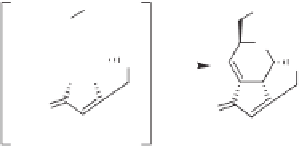Chemistry Reference
In-Depth Information
OAc
OAc
OAc
OAc
O
O
O
O
(i) Co
2
(CO)
8
(i) Co
2
(CO)
8
AcO
O
AcO
O
AcO
O
AcO
O
(ii) NMO
(66 %)
(ii) NMO
(60 %)
O
O
H
3
C
H
3
C
30a
CH
3
CH
3
34a
32b
34b
OSi(CH
3
)
2
C(CH
3
)
3
O
OSi(CH
3
)
2
C(CH
3
)
3
O
O
O
O
O
O
(i) Co
2
(CO)
8
O
O
(i) Co
2
(CO)
8
O
OCH
3
OCH
3
(ii) NMO
(30 %)
(ii) NMO
(41 %)
O
O
O
O
32c
34c
32d
34d
OAc
OAc
OAc
(i) Co
2
(CO)
8
O
O
O
AcO
O
O
AcO
O
(ii) NMO
(32 %)
O
O
CH
3
CH
3
33
35
Scheme 4.9
The first successful Pauson-Khand cyclization of sugar derived enynes.
Independently, Voelter
et al.
published their closely related research on the synthesis
of polyfunctionalized bis-annulated pyranosides (Scheme 4.10).
11
In these reports, in-
tramolecular PKR was applied to propargylmalonate branched-chain sugars
36
and
37
using a catalytic amount of DMSO rather than NMO or other
N
-oxides for the complex
decomposition step; this reaction resulted in bis-heteroannulated pyranosides
38
and
39
.
O
O
OCH
2
Ph
CO
2
Me
CO
2
Me
O
OCH
2
Ph
(i) Co
2
(CO)
8
/benzene, R.T
.
(ii) DMSO, 50
°
C
CO
2
Me
CO
2
Me
36
38
O
MeO
2
C
MeO
2
C
O
OCH
2
Ph
OCH
2
Ph
(i) Co
2
(CO)
8
/benzene, R.T.
(ii) DMSO, 50 °C
MeO
2
C
MeO
2
C
O
39
37
Scheme 4.10
Synthesis of polyfunctionalized bis-annulated pyranosides via the Pauson-
Khand reaction.
In 1995, Mukai and Hanaoka
et al.
reported highly diastereoselective construction of
optically active bicyclo[3.3.0]octenone derivatives
44
and
45
from chiral enynes
43
via
the PKR (Scheme 4.11).
12
The required starting enynes,
43
, were easily prepared from
L-ascorbic acid
40
, or dimethyl L-tartrate
41
via dioxolane intermediate
42
.
















































